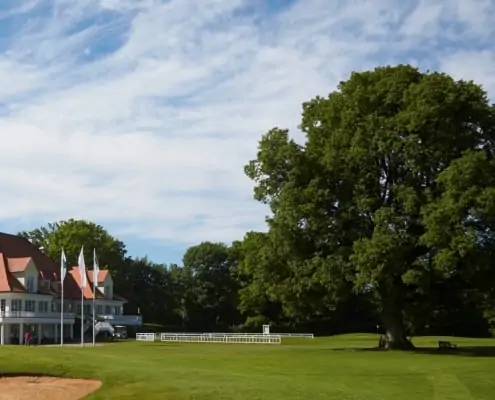On the golf course, the tree needs care
“Our course lives from the trees, the trees are simply part of it.” Christian Löffl, head greenkeeper at the Regensburg Golf and Country Club, knows the solitaires on the 18-hole course in eastern Bavaria very well. And he knows: “One or the other is already ailing.” The origins of the area go back to 1813, when the Princes of Thurn and Taxis began to create what is now the Princely Thiergarten as a hunting forest here in the Bavarian Upper Palatinate.
Increasing weather extremes are increasingly causing problems for the trees on many a German golf course. Because the poor condition, that the 2020 forest condition survey by the Federal Ministry of Food and Agriculture showed for Germany’s forests at the beginning of this year, can also be partially applied to the tree population on golf courses.
Ancient trees suffer from drought stress
“Basically, the situation is dramatic,” says Forest Director Peter Niggemeyer, who manages the forestry and agriculture departments for the Wittelsbach Equalization Fund and is therefore also an expert on the 18-hole golf course at the Wittelsbach Golf Club Rohrenfeld near the Danube. This is also a former hunting ground, the trees were welcome as shade for the horses.
The same applies to the area here in Upper Bavaria as to the area around the golf course in Regensburg: In both cases there are centuries-old trees that are increasingly suffering from drought stress, the leaves are curling up for which the residual water from the topsoil is no longer sufficient. The trees’ defenses are reduced, and pests such as the bark beetle or the oak processionary moth like to move in.
Over the past few months, Christian Löffl has removed around 100 m³ of dead wood from the wooded areas around the 18 fairways in Regensburg. “It hardly ever rains here, you can see that from the fact that the plantings from the 90s are all ailing and the maintenance plantings are having enormous starting difficulties,” he states.
What to do? In Regensburg (picture above) and Neuburg, where the trees largely determine the appearance of the parkland pitches, some of the solitaires are now watered by hand and also supplied with special nutrients.
Targeted measures keep solitaires alive
According to the expert Niggemeyer, this time-consuming and therefore costly maintenance could become standard on many a golf course in the long term. “While the stocks in the forest are largely left to their own devices, the trees on the golf course take advantage of someone tending the course.” The trees often get a little damage from the irrigation measures on the fairways and semi-roughs, as well as targeted measures against pest infestation and the possibility of taking care of the trees individually.
According to Niggemeyer, anyone who wants to plan against drought stress as a precaution has other options for keeping the soil moist.
- Trees in groups have higher crown compaction and thus more shady soil. “The tree feels best in company.”
- If you don’t clear out deadwood between groups of trees and don’t cut down the planting too much, it’s easier to keep the soil moist.
As far as the selection of plants, that are suitable for new plantings, is concerned, he refers to the relatively great helplessness that currently prevails among German experts. “Actually, we try to let nature decide what grows,” but in view of the fact that trees only develop very slowly, the selection of plants is often difficult. “At the moment everything possible is being tried, for example Douglas firs or robinia trees.” According to Niggemeyer, the oak is theoretically a tree that tolerates both drought and water well. In view of the increasing amounts of pollutants in the air and water and extreme weather, the lifespan of oak trees, which would otherwise be up to 1000 years, has now realistically reached 500 years. This is another reason why young oaks are regularly planted next to very old specimens on the golf course of the Wittelsbach Golf Club (picture below).
“Of course, we definitely want to keep our oak trees,” says Christian Löffl, one of the main goals of his work in Regensburg Thiergarten. The trees in need of care have long been an important part of his work. “That has changed drastically. 20 years ago it was all about the fairways, tees and greens, now all of the surrounding nature is pretty essential for greenkeeping as well.”
According to Niggemeyer, this will definitely remain the case. “The golf course is artificial, unlike in the wilderness, you can and want to take care of the inventory here.” Otherwise, many trees are likely to fare like those on which the most recent forest condition survey revolves. The crowns are lightening, the leaves are falling, the pests are coming. And one or another tree, often also a strategic game element on a square, has no chance and perishes.









